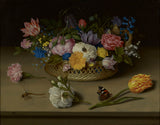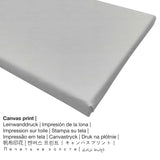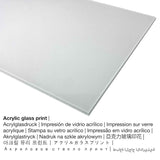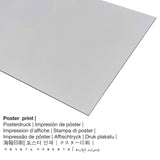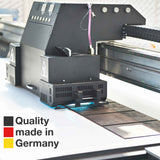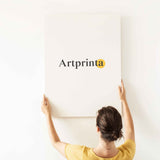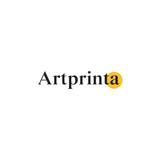Ambrosius Bosschaert the Elder, 1614 - Flower Still Life - ọmarịcha nka
Ụtụ gụnyere. Mbupu gbakọrọ na ndenye ọpụpụ.
Ngwaahịa nka mara mma nkeonwe gị
"Flower Still Life" was painted by Ambrosius Bosschaert the Elder in 1614. Furthermore, the work of art is included in the collection of Ụlọ ihe ngosi nka nke J. Paul Getty. Anyị nwere obi ụtọ ikwu na artpiece, nke bụ akụkụ nke ngalaba ọha is being provided with courtesy of The J. Paul Getty Museum.The creditline of the artwork is the following: . Further, the alignment of the digital reproduction is in odida obodo usoro na nwere ihe oyiyi ruru nke 4: 3, nke pụtara na ogologo bụ 33% ogologo karịa obosara.
(© - nke J. Paul Getty Museum dere - Ụlọ ihe ngosi nka nke J. Paul Getty)
A pink carnation, a white rose, and a yellow tulip with red stripes lie in front of a basket of brilliantly colored flowers. Various types of flowers that would not bloom in the same season appear together here: roses, forget-me-nots, lilies-of-the-valley, a cyclamen, a violet, a hyacinth, and tulips. Rendering meticulous detail, Ambrosius Bosschaert the Elder conveyed the silky texture of the petals, the prickliness of the rose thorns, and the fragility of opening buds. Insects crawl, alight, or perch on the bouquet. Each is carefully described and observed, from the dragonfly's transparent wings to the butterfly's minutely painted antennae. Although a vague reference, insects, short-lived like flowers, are a reminder of the brevity of life and the transience of its beauty.
A rising interest in botany and a passion for flowers led to an increase in painted floral still lifes at the end of the 1500s in both the Netherlands and Germany. Bosschaert was the first great Dutch specialist in fruit and flower painting and the head of a family of artists. He established a tradition that influenced an entire generation of fruit and flower painters in the Netherlands.
Ozi ndabere gbasara akụkụ nka pụrụ iche
| Aha nke ihe nka: | "Ifuru ka Ndụ" |
| Nhazi: | sere |
| Okwu mkpokọta: | nka ochie |
| oge: | 17th narị afọ |
| Emepụtara n'afọ: | 1614 |
| Ogologo afọ nka nka: | ihe dị ka afọ 400 |
| Ụlọ ihe ngosi nka / ebe: | Ụlọ ihe ngosi nka nke J. Paul Getty |
| Ebe ngosi nka: | Los Angeles, California, Njikota Obodo Amerika |
| Ebe nrụọrụ weebụ ihe ngosi nka: | Ụlọ ihe ngosi nka nke J. Paul Getty |
| Ikikere nke ihe osise: | ngalaba ọha |
| Site n'aka: | Ụlọ ihe ngosi nka nke J. Paul Getty |
Onye na-ese ihe
| Aha onye nka: | Ambrosius Bosschaert onye okenye |
| Aha ndi ozo: | Ambrosius I Bosschaert, Ambrosius Bosschaert the Elder, Bosschaert Ambrosius the elder, Bosschaert Ambrosius I, Bosschaert Ambrosius I, Ambrosius Boschart, Bosschaert the Elder Ambrosius |
| okike nke onye nka: | nwoke |
| Obodo onye nka: | Dutch |
| Ọrụ: | ese foto, botanical ihe atụ |
| Obodo onye nka: | mba netherland |
| Nkewa onye nka: | nna ukwu ochie |
| Oge ndu: | 48 afọ |
| A mụrụ: | 1573 |
| Amụrụ na (ebe): | Antwerp, Antwerpen n'ógbè, Flanders, Belgium |
| Nwuru: | 1621 |
| Nwuru na (ebe): | Hague, The, South Holland, Netherlands |
Họrọ ụdị ihe ebipụta nka
Anyị na-enye ụdị nha na ihe dị iche iche maka ngwaahịa ọ bụla. Nha na ihe ndị a bụ nhọrọ anyị na-enye gị maka nkeonwe:
- Kwaaji: The canvas print, which should not be mistaken with a painting on a canvas, is a digital copy printed on a UV direct printing machine. A canvas creates the extra look of three-dimensionality. Furthermore, a canvas creates a familiar and positive impression. Canvas Prints have the advantage of being low in weight. This means, it is easy to hang up your Canvas print without the use of additional wall-mounts. Canvas prints are suitable for all kinds of walls.
- Metal (aluminium debond mbipụta): An Aluminium Dibond print is a print with an outstanding depth effect - for a modern look and a non-reflective surface structure. For the Direct Aluminium Dibond option, we print the chosen artwork right on the surface of the aluminum. The white and bright components of the work of art shimmer with a silky gloss but without any glare. Colors are vivid and luminous in the highest definition, the details of the print are crisp.
- Mbipụta akwụkwọ mmado (ihe kwaaji): A poster is a UV printed flat canvas with a slightly roughened surface finish. A print poster is particularly used for putting the art print with the help of a custom-made frame. Please note, that depending on the size of the poster we add a white margin 2-6cm round about the painting, which facilitates the framing with your custom frame.
- Mbipụta iko acrylic (nke nwere ezigbo mkpuchi iko): The print on acrylic glass, often referenced as a an art print on plexiglass, transforms the original work of art into marvellous décor and offers a great alternative to aluminium or canvas prints.
Product nkọwa
| Bipụta ngwaahịa: | mmepụta nka |
| Mmeputakwa: | dijitalụ mmeputakwa |
| Usoro mmepụta: | UV kpọmkwem obibi |
| Nlụpụta: | German mere |
| Stockdị ngwaahịa: | na mmepụta ihe |
| A na-atụ aro iji ngwaahịa eme ihe: | ihe ndozi mgbidi, foto mgbidi |
| Ndozi onyonyo: | usoro odida obodo |
| Njikwa oyiyi: | 4: 3 ogologo: obosara |
| Oke onyonyo pụtara: | ogologo bụ 33% ogologo karịa obosara |
| Ihe mmeputakwa dị: | acrylic glass print (nwere ezigbo mkpuchi iko), mbipụta akwụkwọ mmado (akwụkwọ kwaaji), mbipụta ọla (aluminium dibond), mbipụta akwụkwọ. |
| Nhọrọ nha nha mbipụta kanvas (akwa akwa na etiti ihe ndọtị): | 40x30cm - 16x12", 80x60cm - 31x24", 120x90cm - 47x35", 160x120cm - 63x47" |
| Mpempe iko acrylic (nwere ezigbo mkpuchi iko) nha dị iche iche: | 40x30cm - 16x12", 80x60cm - 31x24", 120x90cm - 47x35" |
| Nhọrọ nke mbipụta akwụkwọ mmado (akwụkwọ kwaaji): | 40x30cm - 16x12", 80x60cm - 31x24", 120x90cm - 47x35" |
| Nha ebipụta aluminium dibond: | 40x30cm - 16x12", 80x60cm - 31x24", 120x90cm - 47x35" |
| Igwe onyonyo: | biko buru n'uche na nnomi nka enweghi fremu |
Ederede iwu: We try everythig possible to describe our products as clearly as possible and to exhibit them visually. Nonetheless, the tone of the printing material and the imprint may differ marginally from the representation on the device's screen. Depending on your settings of your screen and the condition of the surface, colors can unfortunately not be printed as exactly as the digital version depicted here. Bearing in mind that our fine art prints are printed and processed manually, there might also be minor deviations in the motif's exact position and the size.
Edobere ederede a site na nwebisiinka © - Artprinta.com

